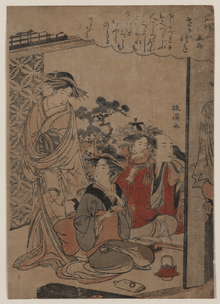Nagauta

Sake Cup by Santō Kyōden, 1783-1784, a meriyasu
Nagauta (長唄), literally "long song", is a kind of traditional Japanese music which accompanies the kabuki theater. It was developed around 1740. Influences included the vocal yōkyoku style used in noh theater, and instruments included the shamisen and various kinds of drums.
The shamisen, a plucked lute with three strings, is a very popular instrument in nagauta. Nagauta performers generally play the shamisen and sing simultaneously.
Nagauta is the basis of the Nagauta Symphony, a symphony in one movement composed in 1934 by composer Kosaku Yamada.
Meriyasu is considered a subset of nagauta.[1][2]
Further Reading
- William P. Malm, Nagauta: the heart of kabuki music (C. E. Tuttle, 1963) Google Books copy
References
- ↑ Santō, Kyōden (1783). "Sake Cup". World Digital Library (in Japanese). Retrieved 28 May 2013.
- ↑ William P. Malm (1963). Nagauta: the heart of kabuki music. C. E. Tuttle Co. p. 17. Retrieved 28 May 2013.
External links
This article is issued from Wikipedia - version of the 10/16/2016. The text is available under the Creative Commons Attribution/Share Alike but additional terms may apply for the media files.